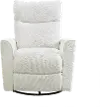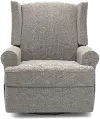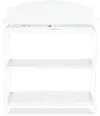Shop Nursery Furniture at RC Willey
The ideal nursery is cozy and comfortable for the baby while also being functional and organized to support new parents. Discover furniture pieces that match your little one's unique personality and are safe and practical, making the nursery a perfect blend of charm and functionality.
#myrcwilleyhome
See how real customers are transforming their spaces with RC Willey. Get inspired, share your style, and create a space that's Your Home. Your Way.
Explore NowChoosing the Right Nursery Furniture
Creating a cozy and safe nursery for your baby is an exciting step. With a few essential pieces, a focus on safety, and trusted brands, you can build a space that’s perfect for your family’s needs.
Essential Pieces for a Baby's Nursery
A well-rounded nursery includes a few essential pieces for comfort and convenience:
- Crib or Bassinet: The crib is often the centerpiece of any nursery. Choose one that meets safety standards and can grow with your child, such as a convertible crib.
- Changing Table: For easy diaper changes, a changing table or dresser with a changing pad offers a convenient height and storage space for essentials like diapers and wipes.
- Rocking Chair or Glider: A comfortable chair is a must for feedings and bonding time. Look for a rocking chair or glider with soft padding and arm support.
- Nursery Recliner: For extra comfort during late-night feedings or story time, a nursery recliner provides supportive seating with a gentle reclining option. Choose one with easy-to-clean fabric and a smooth, quiet recline mechanism.
- Kids' Rugs: Soft, colorful rugs add a cozy touch to the nursery while providing a safe, cushioned play area for your little one. Opt for rugs that are easy to clean and durable enough to handle everyday spills and messes.
Importance of Safety and Functionality
When it comes to nursery furniture, safety is the top priority:
- Look for Certifications: Check that furniture pieces meet safety standards, such as ASTM or JPMA certification for cribs and other essentials.
- Focus on Stability: Choose sturdy furniture that won’t tip over easily, especially as your baby grows and becomes mobile. Anchor furniture to walls if possible.
- Functional Features: Many nursery pieces, like convertible cribs or multi-purpose dressers, are designed to grow with your child, making them a practical investment.
By focusing on safe, functional furniture, you can ensure peace of mind while making the most of your nursery space.
Nursery Furniture Setup Timeline
Getting the nursery ready can feel overwhelming, but with a clear timeline, you’ll be prepared and stress-free by the time your little one arrives. Here’s a guide to help you plan each step.
Ideal Timing for Setting Up Nursery Furniture
Most parents start setting up nursery furniture during the second trimester, around weeks 20 to 24. By this time, you’ll likely know your baby’s gender (if you choose to), and you’ll have a better idea of your decorating preferences and furniture needs. Starting early ensures you have plenty of time for deliveries, setup, and adjustments.
Planning Around the Baby's Due Date
It’s a good idea to aim for a fully set-up nursery by around 36 weeks. That way, you’ll have a calm, organized space ready if your baby arrives early, and you’ll have time to get comfortable with the new layout. If you’re tight on time, prioritize assembling the crib and organizing essential items first.
Checklist for a Ready-to-Use Nursery
Make sure your nursery is fully equipped and ready to welcome your baby. Here’s a checklist to keep you on track:
- Crib Assembled and Ready: Make sure your crib or bassinet meets safety standards and is placed away from windows or cords.
- Changing Area Setup: Include a changing table or pad, along with organized diapers, wipes, and creams.
- Clothing Storage and Organization: Wash and store baby clothes, burp cloths, and blankets in drawers or baskets.
- Feeding Station Prepared: If you plan to feed in the nursery, set up a comfortable chair and keep bottles, nursing pillows, or other feeding essentials nearby.
- Safety Check: Anchor furniture, cover outlets, and remove any potential hazards.
Creating a Stylish and Comfortable Nursery
Designing a nursery that’s both cozy and stylish involves selecting colors, furniture, and decor that balance comfort with aesthetics. Here’s how to make your baby’s space modern, functional, and inviting.
Current Nursery Color Trends for 2024
For 2024, nursery color trends are leaning toward soothing, earthy tones with subtle pops of color:
- Earthy Neutrals and Warm Shades: Colors like sage green, warm taupe, and soft terracotta are popular choices, creating a calm, cozy feel. These shades pair well with natural materials, making the room feel more organic.
- Pastels with a Modern Twist: Pastel hues like blush pink, mint green, and soft blues remain favorites, but with slightly deeper, muted tones. These colors work well as accent walls or in combination with natural wood.
- Accent Colors: Adding small pops of brighter colors, like mustard yellow or coral, in the form of wall art, cushions, or rugs, can give the room personality without overwhelming the senses.
Tips for a Cohesive and Stylish Design
Pulling together a cohesive nursery look is all about balance:
- Stick to a Color Palette: Choose a primary color or theme and complement it with coordinating colors. This ensures the space feels unified rather than overly busy.
- Layer Textures for Warmth: Soft rugs, cozy blankets, and layered curtains add dimension and warmth. Using different textures, like a wool rug paired with a cotton crib sheet, keeps the room feeling inviting.
- Personal Touches and Minimal Decor: Incorporate personal elements, such as family photos or handmade items, to make the space feel unique. Simple, intentional decor keeps the nursery calm, rather than overstimulating.
Budget-Friendly Nursery Options
Creating a cozy and functional nursery doesn’t have to break the bank. Here are some practical ways to set a reasonable budget, find affordable furniture, and consider second-hand or DIY options.
Setting a Reasonable Budget for Nursery Furniture
Before shopping, decide on a budget that balances your needs with your financial comfort level:
- Allocate for Essentials First: Start by prioritizing big-ticket items like the crib, changing table, and storage. Aim to spend more on these essentials if possible, as they’re used daily and often need to meet specific safety standards.
- Plan for the Extras: Allocate a smaller portion of your budget for decorative items like rugs, artwork, and toys. These items can be gradually added or even replaced as your child grows, giving you flexibility to save on decor.
How Much Should I Budget for a Nursery?
The cost of setting up a nursery can vary widely depending on the style, quality of furniture, and the number of items you choose. On average, parents spend anywhere from $1,000 to $3,000 or more, depending on their preferences. Here's how the costs typically break down:
- Crib and Mattress: The crib is the most important piece of furniture and can range from $100 to $1,000. Budget cribs can start at around $100, while higher-end models, including convertible cribs, often cost between $500 to $1,000. The mattress can cost an additional $50 to $200 depending on the brand and quality.
- Changing Table and Dresser: Expect to spend about $150 to $500 for a changing table, or opt for a combined dresser/changing table unit, which can range from $200 to $800. Some parents may even repurpose a dresser they already own to save money.
- Storage and Organization: Bins, baskets, and shelving to keep baby items organized usually cost between $50 to $300. This includes essential items like diaper pails, clothes hampers, and drawer organizers.
- Rocking Chair or Glider: A comfortable chair for feeding and bonding is often priced from $100 to $600. A well-built glider or rocking chair will offer long-term comfort and versatility, but you can find budget-friendly options starting around $100.
- Bedding and Decor: Bedding sets, including sheets, blankets, and bumpers, typically cost $50 to $200. Decor like wall art, rugs, and curtains can range from $50 to $500, depending on the style and quality.
- Miscellaneous Items: Don't forget items like a diaper bag, humidifier, nightlight, and baby monitor. These can add up to $100 to $300.
Tips for Staying Within Budget
- Prioritize Essentials: Focus on purchasing the most important items first, such as the crib and changing table. You can gradually add decor or extra furniture as needed.
- Shop Sales: Take advantage of RC Willey’s sales! We offer sales like our Memorial Day, Labor Day and Black Friday/Cyber Monday sales, as well as regularly having products on sale. Check out our Sale page today!
- Opt for Multi-Use Furniture: Convertible cribs or dressers that double as a changing table offer great value by growing with your child.
In total, budgeting $1,000 to $2,500 for a basic but functional nursery setup is a reasonable target. Keep in mind that you can always adjust based on your priorities, the quality you’re looking for, and whether you choose new or secondhand items.
Frequently Asked Questions About Nursery Furniture
If you’re new to baby furniture or have concerns about setting up a nursery, you might have some common questions. Here are a few to help guide you in the right direction.
- What is Baby Furniture Called?
Baby furniture refers to pieces specifically designed for use in a baby's room or nursery. These include essential items like cribs, changing tables, dressers, rocking chairs, and storage units. Furniture pieces are typically designed with both the baby’s safety and comfort, as well as the parents’ convenience, in mind. Nursery furniture often comes in matching sets, but individual pieces can also be purchased based on specific needs.
- Understanding the Term 'Nursery' for a Baby's Room
The term "nursery" typically refers to the room designated for a baby, which is specifically set up with baby furniture and decor. It’s a space that includes all the essentials, from sleeping arrangements (like a crib) to storage for baby clothing, toys, and essentials. While the term "nursery" may also be used more broadly to describe a room for young children, it’s most often associated with newborns and infants.
- Addressing Common Parental Concerns About Furniture Safety
When it comes to baby furniture, safety is a primary concern for parents. Here are some common issues and tips to ensure a safe nursery:
- Crib Safety: Ensure the crib meets current safety standards. Avoid cribs with drop-side rails and make sure the mattress fits snugly with no gaps.
- Stability: Ensure all furniture is sturdy and anchored to the wall, especially as babies grow and begin to pull themselves up. Tip-resistant furniture is crucial to prevent tipping accidents.
- Materials: Look for baby furniture made from non-toxic materials and finishes. Many cribs and dressers are now certified as free of harmful chemicals by third-party organizations, so be sure to check certifications for peace of mind.










































